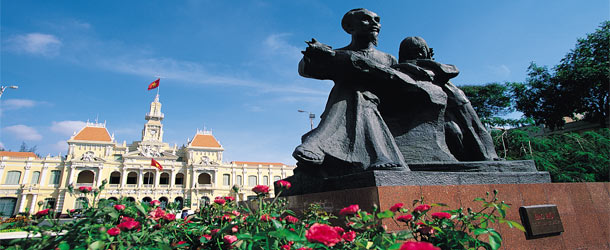A cruise along the river Mekong involves a visit to a number of Cambodia and Vietnam’s most iconic cities and sites and depending on the direction your itinerary follows, will either begin or end in Ho Chi Minh City. Lively and bustling, it offers a wealth of cultural, not to mention culinary experiences, and there’s plenty of opportunity to explore the history of its French colonial occupation as well as the role it played during the Vietnam War.
Ho Chi Minh City has certainly come a long way and seen a lot of history since its humble beginnings as a fishing village, originally populated by the Khmer people. Today, it’s the largest city in Vietnam and its most populated area, though much of its significant history was made when it was known as Saigon, in a time when it was the capital of the French Cochinchina colony and later of the independent republic South Vietnam, between the years of 1955-75. It was between these years that the Vietnam War took place and following a Communist victory and the fall of Saigon, the city merged with the adjacent Gia Dinh Province and was renamed Ho Chi Minh City.
What’s not to miss
Saigon Opera House
The opera house is one of the city’s most well-known landmarks when it comes to buildings and a great example of the French colonial architecture that can be found there. On a tour of the city, it’s likely you’ll only have enough time to take in the building from the outside, but if you have time to go inside, do, as the décor is equally special. If you’re staying in Ho Chi Minh overnight, then a show at the Opera House is a must and the absolute best way to experience what the building has to offer.
Cao Dai Temple
In stark contrast architecturally and culturally, the Cao Dai Temple is another must-see structure. It is eye-catchingly colourful inside and out and it’s a safe bet to say that you won’t see another one like it on your travels. It’s not located in the centre of the city itself, so you’ll only realistically be able to visit if you book an excursion to see it or if you have a couple of days in the city and enough time to make the trip on your own.
Dong Khoi Street
A stroll down this famous street is a great way to get a feel for the city’s past and enjoy a spot of retail therapy while you’re doing it. You can see celebrated examples of French colonial architecture such as Notre Dame Cathedral and the old Post Office as you walk and there’s an impressive array of high end boutiques to peruse, selling all-manner of silks, artworks, as well as your more contemporary Rolex and Ralph Loren wares.
Reunification Palace
This perfectly preserved old government building is your chance to step back in time to 1966, to a time when the Vietnam War was raging and when the building played a significant role in the conflict. It’s opulence 1960’s Communist style, and though it’s dated it’s still impressive when you consider how large numbers of the Vietnamese people lived during the time. A guided tour is advisable if you really want to bring your visit to life, as some of the rooms are pretty utilitarian.
War Remnants Museum
For a thoroughly frank, humbling and immersive look at the Vietnam War, be sure to visit the War Remnants Museum. It’s packed with informative, fascinating and sometimes very unsettling exhibits, photographs, films and artefacts related to the conflict. As you would expect, it offers an overview of the war from the Vietnamese perspective and pulls no punches when it comes to bringing home the futility and brutality of war to the thousands of visitors it attracts each year.
By Simon Brotherton
Google



